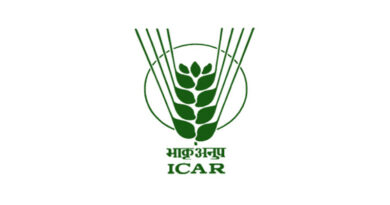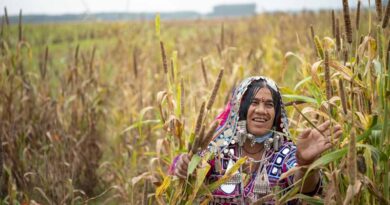City dwellers develop appetite for nutrient-rich grains shunned by Zimbabwe smallholder farmers
20 July 2023, Zimbabwe: While Zimbabwe’s smallholder farmers have shown little interest in growing nutrient-rich small grains for years, consumers in the country’s major cities have a massive appetite for traditional culinary delights such as groundnuts, round nuts, cowpeas, and millet.
This is happening when the science of climate resilience is persuading the large-scale embrace of small grains as a sure shot toward attaining food security.
“The demand for these grains is high, but it is difficult to get the produce from rural areas as many villagers prefer growing corn.”
Ideally, traditional foods are making their way back to diets because of their affordability and high nutritional value.
And this is recommended by experts in a country where nutrition, malnutrition, and undernutrition have become buzzwords of the long-running food crisis.
At a bustling al fresco market outside Bulawayo’s central business district that has become the go-to place for anything that ranges from dried vegetables to groundnuts, pearl millet to wild honey, Sithabisile Mlambo has a ready customer base.
Cereal insecurity levels for urban areas decreased from 42 percent in 2020 to 29 percent in 2023.
“The demand for these grains is high, but it is difficult to get the produce from rural areas as many villagers prefer growing corn,” Mlambo said.
Under an unusually scorching June sun — perhaps another sign of climate change due to global warming because June is usually the coldest month — Mlambo sits among hundreds of traders in a market where agricultural produce from across the country finds ready consumers.
Bulawayo’s thriving small grains market, where Mlambo and others earn a living, could provide an insight into the importance of the large-scale adoption of small grains.
Customers travel from different ends of the city, and it is not just nostalgic residents recalling the dietary regimes of their childhoods.
“We have seen all types of people here. People from the diaspora and the townships come here. There is always demand for traditional foods,” Mlambo said.
“The reintroduction of traditional small grains offers a partial solution, but it requires specialized technical advice and harvesting equipment, which is not yet widely available.”
Finding a working balance of malnutrition busters as part of locally based solutions has proven difficult, especially against escalating food prices as inflation continues to erode consumer spending on basic commodities.
However, amid such apparent promise of the popularity of nutrient-rich foods, United Nations Children’s Fund (Unicef) has noted that Zimbabwe’s “existing food systems do not comprehensively tackle the child malnutrition problem.”
While Mlambo accepts the popularity and demand for small grains and traditional foods, adult urban populations have also been caught in the crosshairs of malnutrition.
The World Food Programme says while Zimbabwe’s move to adopt small grains to boost nutrition is encouraging, more needs to be done.
“The reintroduction of traditional small grains offers a partial solution, but it requires specialized technical advice and harvesting equipment, which is not yet widely available,” said Maria Gallar, WFP Zimbabwe spokesperson.
While urban residents are eager to consume traditional grains, other factors, such as the affordability of balanced diets, push back the country’s nutrition ambitions.
“Unfortunately, not all rural households can benefit from these investments due to adverse local growing conditions and inadequate or irregular rainfall during the growing season.”
Rural areas are failing to supply Mlambo and other traditional food vendors with enough produce that is in high demand in the cities, such as Bulawayo.
While urban residents are eager to consume traditional grains, other factors, such as the affordability of balanced diets, push back the country’s nutrition ambitions.
Unicef has also noted that “nutritional deficiencies in the population, together with insufficient quality nutrition services, contribute to Zimbabwe’s biggest challenges and create the largest burdens on the health system.”
The popularity of nutrient-rich small grains is expected to boost production, with farmers’ unions reporting a slight increase in the acreage under small grains — from 380,000 hectares in 2020 to 390,000 hectares in 2021.
“There must also be the upscaling of information about the types of foods people must consume and the promotion of small grains among farmers.”
According to the 2023 Urban Zimbabwe Vulnerability Assessment Committee (ZimVAC) results, the cereal insecurity levels for urban areas decreased from 42 percent in 2020 to 29 percent in 2023, highlighting the food insecurity situation that continues to stalk urban residents.
“The country needs improved benchmarks in determining nutrition issues because there appears to be a persisting between what official reports say and what people are experiencing,” said Clemencia Makhurane, a nutritionist and researcher working with various non-governmental organizations in Bulawayo.
“There must also be the upscaling of information about the types of foods people must consume, and that includes the promotion of small grains among not just ordinary people but farmers,” Makhurane said.
For now, the traditional food market in Bulawayo, Zimbabwe’s second city, remains vibrant, providing Mlambo and many others an income and the promise of the future of small grains as the country navigates climate uncertainty.
Also Read: LI-COR onboards new distributor DTPLENVIRO Techsolutions to expand its presence in India
(For Latest Agriculture News & Updates, follow Krishak Jagat on Google News)















